13 March 1990
Editor’s note: It is Valentines Day. If you have someone to hug, please do so. We have more weird weather here in Washington, restricting travel, and adding to the complexity of political life is the passing yesterday of Associate Justice Antonin Scalia. RIP. Nomination of his successor is going to be another part of the puzzle. Accordingly, it is safer to venture back to other times. Here are some tombs from another day.
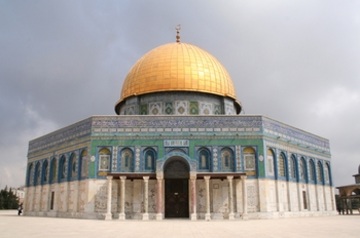
(Dome of the Rock on a cloudy day).
We arise early in Tel Aviv and start to clear the cobwebs. I treat Doc Feeks to a prophylactic Alka-Seltzer and read the Jerusalem Post with steaming hot coffee. The leadership crisis is percolating nicely; there may be a Government here later in the day and there may not. The issue is negotiations with the PLO over the fate of the West Bank. This is of some interest, as we are bound for the Capital that morning.
We decided to throw our wallets to the wind and hired a car and driver to take us to Jersualem for some power Holy Landing.
Our guide is Svi Ginzberg, a Polish-German-Sabra of 67 seasons. He wears a 9mm Browning unobtrusively in his belt and drives a Mercedes Cab. He whisks us out of the Hilton Parking Lot at precisely 1030. We hit the four-lane Route One to Jerusalem and speed along as he regales us of tales of the country to which he came in 1934. Every tree was planted, he says, and the Jews have remade much of this place in their own blood. We pass scenes of heavy fighting in ’47, and he points them out with the authority that only a veteran can give.
We pass one of the British Police Forts which were turned over to the Arab Legion and he describes the action around the place the happened in his living memory.
As we roll up the hills toward the City we pass the burned-out hulks of vehicles from the Jewish convoys shelled by the Arab Legion. The twisted metal has been painted with Rustoleum as a preservative and stones raised to commemorate the dates of the destruction. We cross the areas where the old border ran and Svi provides commentary on the desperation of ’47 and the triumph of ’67 when they were eliminated.
There is thick fog at the Knesset Building, Jerusalem’s Capitol Hill; we can’t see a thing. When we get to the walls of the Old City, the cloud has lifted and vision is much improved. We are dropped at the Jaffa Gate while he parks the car and we wander down through the Arab quarter and the Souk, and then into the Jewish Quarter. Things are shut tight, because of the Intifada; the PLO edict that all shops must close at 1300 to spite the Israelis, who they consider occupiers, not rightful owners.
They are, of course, cutting their own noses to spite their conquerors. Some shop-owners hiss to attract attention from behind closed doors, eager to do business on the sly. Toad and I buy camel whips from a turbaned Arab. You never know when they could come in handy, and after what we saw in Egypt, anything could happen.
We pass the archeological excavations in the Jewish Quarter, and then on to the West Wall of the Temple Precinct where Svi guides us to a newly excavated section of the Wall, where Svi is reprimanded by a young man for explaining what the goyem are seeing while Hasidim are swaying in prayer. As we leave, hands clapped over the cardboard Yarmulkes Svi has directed we wear in respect, he says that normally Jewish prayer is so loud that nobody would notice, except for the particular prayer that these strangely-clad devotees.
He then discussed the peculiar laws that govern the life of what he calls the Religious Men. A good Jew, he says, cannot walk into the Temple Grounds on the mount above us because they are prohibited from walking on the Holy Soil of the Temple. Since no stone has been left standing on another from the Second Temple, no man may know where the sacred soil begins.
I think it happens to everyone who visits the Holy City- it is an intoxicating sense of immediacy, the past so jumbled with the stories we all know, and living tangible all around us. On the Temple Mount, we peer into the Dome of the Rock. Svi ushers us quickly past, although we could have removed our shoes and gone in to see what may be the alter upon which Abraham had laid his son for sacrifice, or the place Muhammed left his footprint as he leapt to the skies after the miraculous night ride from Mecca on the winged steed al-Buraq.
“Although sometimes referred to as the Mosque of Omar, the Dome of the Rock is in fact not a mosque,” Svi told us. “It is a shrine, but it is oldest extant Islamic monument, and served as a model for architecture across three continents for a millennium.”
“Did the Muslims intentionally usurp the monuments of the older faiths?” I asked.
Svi just smiled thinly. He has his opinions but is not sharing them. There is a small dark wooden plaque on a stone wall that informs us the Dome was used as a Crusader Chapel for more than a hundred years when the Christians took back the city
I found out later why Svi, so even handed in his treatment of the religions, has little interest in the places of the Muslim faith. I came at the epiphany sideways when I asked him how many children he had, since he had spoken of his grand-daughter who is serving in the IDF now for her National Service.
“I have a daughter who is 42 years old” he says. “My son was killed at eight o’clock in the evening on the sixth of June, 1983, in a tank engagement with the Syrians. He lived for ten hours but never· roused from his coma.”
That shut us up pretty effectively. Like I say, everyone here has a story.
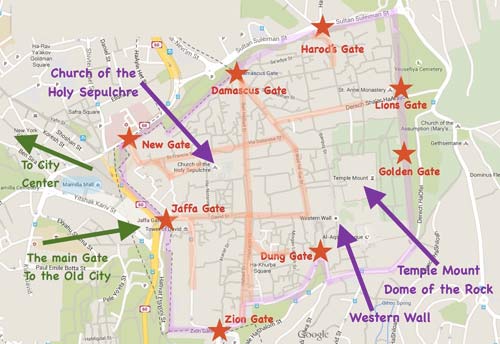
We walked down from the Temple Mount and to the Via Della Rosa, where we walked the Stations of the Cross from Station Three, where the ancient Roman paving has been excavated and brought to the surface. I knelt on the large uneven stones where Christ walked because I felt I had to.
We followed the path slowly uphill to the Church of the Holy Sepulcher. This slightly shabby church was damaged in the most recent of dozens of earthquakes and workmen bustled about with tools and wheelbarrows. A cassocked priest in stark black talked animatedly on the telephone inside the door.
A crazy hodgepodge of stones from the time of Constantine and Crusader days smade up the outside. Inside, is located one of the sites of the location of the True Cross, where I got to my knees to touch the spot. We entered the Sepulcher itself, where the accident of the queue in the line has me enter the tomb of the Living God with four Attack bubbas from VA-176.
A greybeard Greek Orthodox priest lights candles for us in exchange for Skipper Rocco Montesano’s five-dollar bill. I try hard for a devout feel but it doesn’t come. It feels like Tijuana. The surreal atmosphere is increased by the presence of the Egyptian Coptic Priest whose niche abuts the rear of the Sepulcher. He hisses out of the darkness for alms.
All denominations have specified pieces of the action at all the shrines.
Then we walked out of the walled city, Arabs entreating us to visit the (officially) shuttered shops. We buy a bagel from a street cart and wait for Svi to pick us up. We are moderately surprised when he rushes up on foot gesturing wildly. “The Intifada has hit me,” he says. “I am sorry for the delay, but they have broken my car window with stones.”
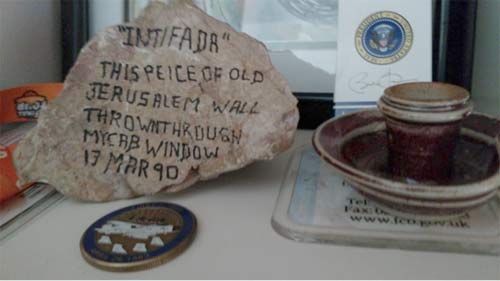
(Svi did not need the rock itself for the insurance claim, and he graciously bequeathed it to join the mound of junk I have lugged around the world since).
I have the guiltiest rock in question now, a piece of the old city wall, ominous in its weight, heavy and three-cornered. It had exploded the glass all over the front seat of the car and lay silently next to the gearshift amid the debris. Nothing is stolen; this is a political stoning.
Some youthful Arabs have targeted the cab because of its Israeli license plates.
Svi left us to drive off to make a police report and drops us to wait at the King David Hotel, once used as the Quarters for the British Officers assigned to the Holy City. We enjoy a cold Maccabi beer in the elegant lobby, just this side of where the building collapsed from the explosion of the bomb planted by the young freedom-righter Menachem Begin.
We are just finishing when Svi returned and we piled into the car for the trip to what may be the real Golgotha and what the Church of England considers to be the actual site of the Crucifixion and Resurrection.
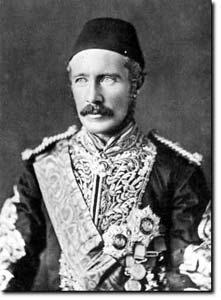
(Major General Charles George Gordon, killed by Islamists at Khartoum in 1885 while serving as Governor-General of the Sudan. His nickname “Chinese Gordon” was earned by his exploits in China during the “Arrow War.” He served virtually everywhere in the world and left his boot-print in Jerusalem at the zenith of the British Empire. Stop me of this seems oddly familiar).
Here’s the deal: General “Chinese” Gordon was in Jerusalem for a visit in 1883. Like everyone who visits, he got infected with the Holy City virus. While touring, he noted that the conventional site of the crucifixion and tomb of Jesus is inside the Old City Walls. In his Christian mind, he thought that Jewish doctrine would not have permitted the burial there, even if the Romans had decided to execute him inside the walls. While touring the sacred sites, Gordon spied a prominent rocky crag which looked to him like it could be the “place of the skull” mentioned in the Bible as where Jesus was crucified.
Around the corner, Gordon identified an ancient tomb. Putting the two together, he located the hill of crucifixion and the nearby burial place.
It is a place of quiet beauty and peace. An Arab cemetery now occupies the summit of Skull Rock, but we gazed from the viewing place over the bus depot. We have our pictures taken in front of the Tomb of the Living God, and lie briefly in one of two excavated graves inside the cave. It might be The One, we tell each other.
“Why not try them both?” asked Doc Feeks. “It can’t hurt to be certain.”
“Leaving no stone unturned,” I said.
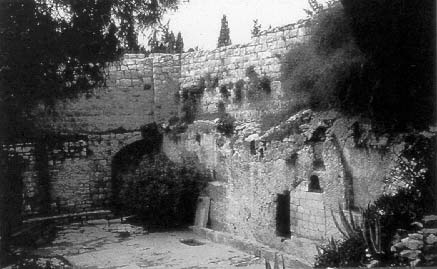
(The Garden Tomb’s entrance at lower right).
Copyright 2016 Vic Socotra
www.vicsocotra.com
Twitter: @jayare303
.
